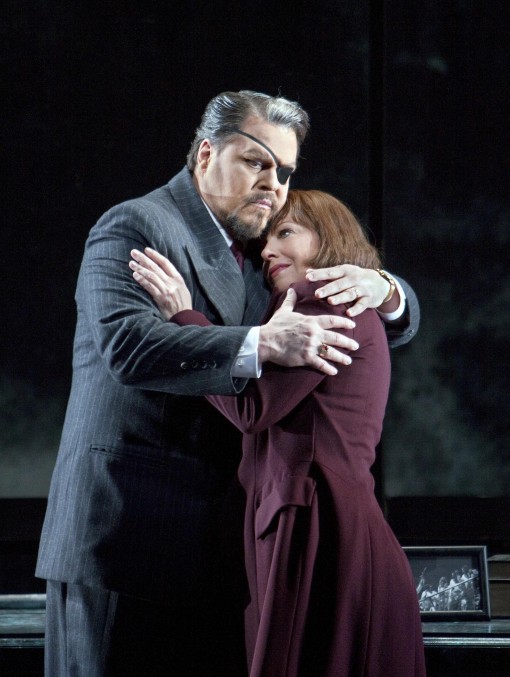Intimate human emotions triumph in San Francisco Opera’s “Die Walküre”

Mark Delavan as Wotan and Nina Stemme as Brünnhilde in Wagner's "Die Walküre" at San Francisco Opera. Photo: Cory Weaver
San Francisco Opera’s production of Die Walküre, presented Wednesday night at the War Memorial Opera House, largely follows the pattern set by Das Rheingold — some superb singing, inspired musical direction by Donald Runnicles and a staging by Francesca Zambello that doesn’t quite work as a unified conceit but manages to convey the humanity of the opera.
Wotan is now a corporate CEO in tightly buttoned double-breasted suit, his Valhalla a boardroom in the clouds. Michael Yeargan’s sleek steel set — and his industrial chic scaffolding for Act 3 –are visually striking, but does this concept really bring any fresh insights to the work or characters? When Brünnhilde, wielding Wotan’s spear, climbs atop her father’s boardroom table to commence with the Hojotoho-ing, it makes for a great production photo but just seems silly. In Act 3, the Valkyries are a band of hardy parachutists, dropping in and flying across the stage.
Once again, the updated staging is most successful when it’s least coy. The opening scene when Siegmund discovers and falls in love with his sister Sieglinde is engaging and effective (Yeargan’s wry evocation of rural American kitsch in Hunding’s hut is so clever and dead-on you half-expect to see a velvet painting of dogs playing poker next to the elk heads.) The designer’s desolate littered urban setting for the fight between Siegmund and Hunding evokes the under-the-freeway Rumble from West Side Story. And the daunting three walls of real fire that surround Brunnhilde in the final scene must be giving migraines to officials at the San Francisco Fire Department.
If the updating doesn’t really cohere, even with Yeargan’s stylish visuals, Zambello is undeniably effective in conveying the opera’s deep humanity. Those moments of intimacy and love—romantic between Siegmund and Sieglinde and familial between Wotan and his daughter Brünnhilde—are really what Die Walküre is all about and why it remains the most popular of the Ring operas.
In the four principal singers, San Francisco Opera has really managed to cast from strength. Brandon Jovanovich was just terrific as Siegmund. The American singer may not be a Heldentenor in the classic tradition but his instrument has power, juice and an exciting vibrancy. Jovanovich is also a wonderful actor and vividly conveyed the confusion, impetuosity and romantic intensity of the ill-fated hero.
As his twin sister and Hunding’s put-upon wife, Anja Kampe was an equally vital presence. The soprano was a bit short-breathed in Sieglinde’s high-flying moments, but she too put across the desperate passionate essence.
In her role debut, Nina Stemme made an inspiring Brünnhilde. Some of the daddy’s girl business was overdrawn, but the Swedish soprano sang with resplendent tone and great sensitivity, conveying the fiery warrior side of Wotan’s daughter as well as her sympathy for the plight of Siegmund and Sieglinde.
Mark Delavan built on his previous Wotan, rising to a performance of stature and emotional resonance. The voice remains too small for the role, yet the American baritone handled Wotan’s two great monologues with vocal poise and an apt world-weary expression. The final scene wherein the furious god forgives his defiant daughter for her disobedience offered the highlight of the cycle so far. Even with some clear vocal wear at the end of the long evening, Delavan sang with an affecting poignance and stoic melancholy. Stemme was also at her finest, and the scene was most sensitively directed by Zambello.
Elizabeth Bishop improved on her already worthy Fricka, bringing an ample mezzo and firm force to her demands that Wotan must allow Siegmund to die as punishment for the twins’ incest. Following his Fafner in Rheingold, Daniel Sumegi was an equally malignant Hunding, singing well and painting the brutish lout who swills beer and manhandles his wife.
The parachutist Valkyries (Sara Gartland, Melissa Citro, Daveda Karanas, Lauren McNeese, Tamara Wapinsky, Maya Lahyani, Renee Tatum, and Cybele Gouverneur) were a vocally uneven crew, with some chaotic ensemble moments. Jan Hartley’s atmospheric video projections helped set the forest scene and mercurial moods, the shifting colors aided by Mark McCullough’s lighting.
Donald Runnicles’ idiomatic and sensitive musical direction continues to be a principal asset in this cycle. The orchestral playing was largely worthy but overall less polished than for Rheingold. There were moments of slack ensemble and a few jarring horn bloopers from a sometimes raw-toned brass section. Hunding’s hunting horns were strangely inaudible.
Die Walkure will be repeated 7 p.m. June 29. sfopera.com/ring; 415-864-3330.